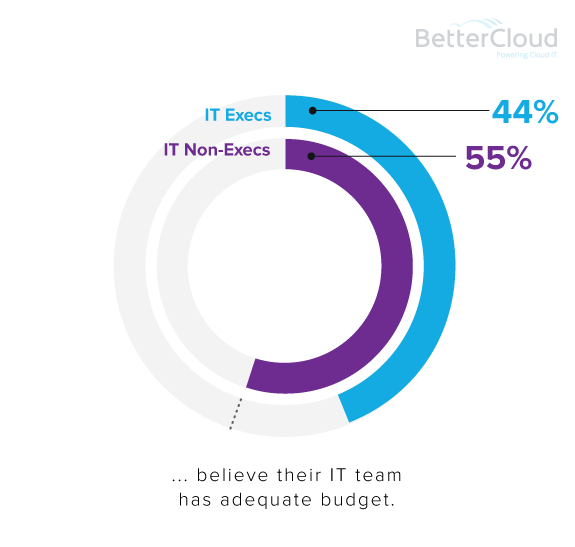IT Exec Disconnect: New Data Suggests IT Executives and Their Teams Are Out of Sync
October 25, 2016
5 minute read

We are a few weeks removed from our last Trends in Cloud IT post, where we showed the undeniable rise of SaaS applications and the challenges that come along with rapid adoption. Now, we want to hone in on another, less talked about topic: the differing views of IT executives and non-executive IT staff.
What we have found is a divide within IT. On just about every topic in this post, entry-level admins, managers, and senior IT professionals see things through a different (perhaps more accurate lens) than IT executives (VPs and CIOs).
It’s fascinating.
IT executives often struggle to see many of the critical issues their departments face. As a result, many are unaware of the cracks in their IT environment that are forming beneath their feet.
On the other side, non-executive IT staff tend to see a more challenging side of IT, especially when it comes to the control and visiblity of SaaS applications, user lifecycle management, staffing, and budget.
DEMOGRAPHICS
84% of our IT respondents use G Suite or Office 365.
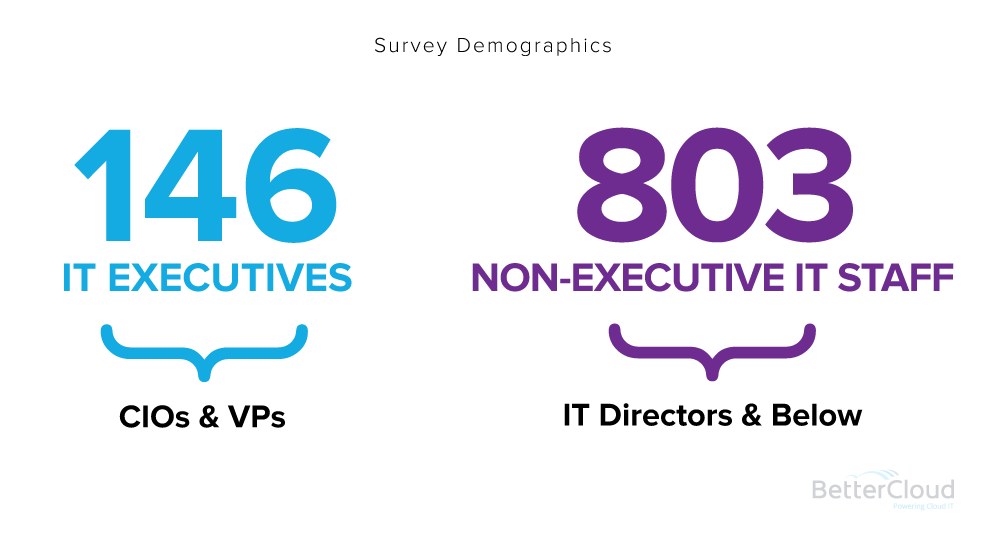
CONTROL
Non-executive IT staff, when compared to IT executives, are 29% more likely to say their team lacks complete control over their SaaS applications.
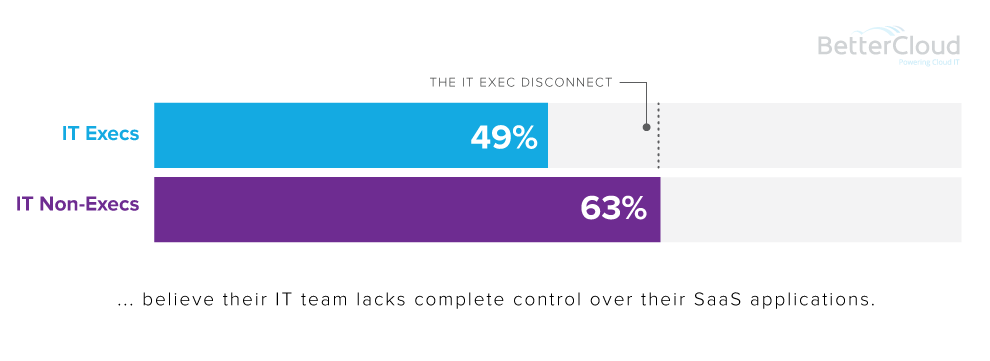
As we showed in our last Trends in Cloud IT post, SaaS application adoption isn’t slowing down. IT executives (who likely don’t manage SaaS applications on a daily basis) are more optimistic about their ability to control them. IT non-executives (who interact more with SaaS applications) are more likely to feel uncertain about the control they have over them.
We believe this data point shows that many non-executive IT staff have a more realistic picture of what’s going on in their own environments than the IT executives they work under.
Still, this shouldn’t overshadow the fact that the majority of IT teams, regardless of role, say they don’t have control over their SaaS applications.
 VISIBILITY
VISIBILITY
Non-executive IT staff, when compared to IT executives, are 56% more likely to feel like their IT team lacks complete visibility into their SaaS applications.
Again, we see a disconnect here. IT executives believe their teams have more visibility into their SaaS applications than they likely do. Nearly half of all IT team members lack visibility into their SaaS applications. So not only are they struggling to control their SaaS applications, most are unable to even see how they’re being used.
 ONBOARDING
ONBOARDING
Non-executive IT staff, when compared to IT executives, are 61% more likely to say that more than a quarter of new hires lack access to the right SaaS applications.
More than a quarter of new hires lack access to the right SaaS applications during onboarding, according to non-executive IT staff. IT executives report far less onboarding issues and as a result, likely assume that new hire onboarding is much smoother than it is in actuality.
Productivity takes a hit when a new hire lacks access to a SaaS application necessary for their job. At scale, this could cost organizations thousands of hours of productivity.
 OFFBOARDING
OFFBOARDING
Non-executive IT staff, when compared to IT executives, are 139% more likely to believe that former employees still have access to company data.
For whatever reason, many executives are unable to see the cracks in their IT environments. IT team members, who are largely responsible for the offboarding of employees, see the vulnerabilities more clearly. IT team members likely have a more intimate knowledge of the offboarding process, making glaring offboarding issues easy to spot. Either non-executive IT staff aren’t communicating the issues accurately or executives aren’t asking.
Either way, it presents a huge security risk.
According to non-executive IT staff, almost one in every three companies have data that is accessible by former employees. That’s a sobering statistic and one that needs to be addressed.
STAFFING
Non-executive IT staff, when compared to IT executives, are 41% more likely to say their team is understaffed.

The disconnect extends beyond technical challenges. IT executives don’t recognize how thinly stretched their teams are. The majority (54%) of IT team members feel their teams are understaffed–just 38% of IT executives say the same.
It’s hard for any employee to approach a superior and say, “We need to hire two more people.” But for many organizations, it’s a conversation that must take place.
 BUDGET
BUDGET
Non-executive IT staff, when compared to IT executives, are 25% more likely to feel like their IT teams lack budget.
Lack of budget is an issue that roughly half of all IT professionals feel. However, IT team members notice constricted budgets more than their bosses do.
When you look at the fact that many employees have upwards of five SaaS applications (in some cases, more), it’s easy to understand why wallets are thin. And as we’ve previously highlighted, the budget issue is more pronounced when it comes to SaaS security.
PERCEPTION
The majority of IT professionals, regardless of role, view their IT teams as a competitive advantage for their organization.

Despite the major hurdles they must overcome, the majority of IT professionals believe they are making a difference. Now, the question becomes: What could IT teams do if they were on the same page? If everyone is rowing in the same direction, how much more of an impact could be made?
Stay Tuned for the Next Trends in Cloud IT
We are just getting started and have only dissected a fraction of our 2016 Trends in Cloud IT data. If you would like to receive the next Trends in Cloud IT post as soon as it’s published, subscribe to the BetterCloud Monitor daily newsletter.




 VISIBILITY
VISIBILITY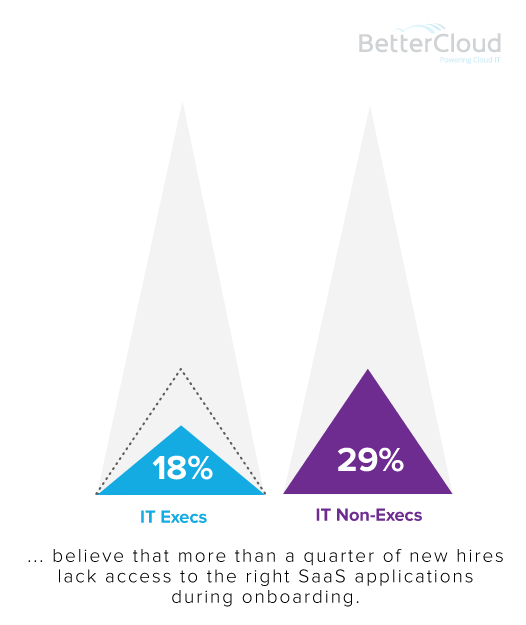 ONBOARDING
ONBOARDING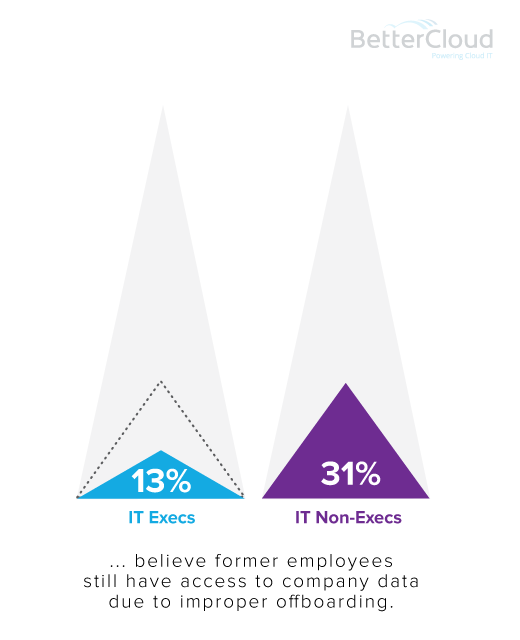 OFFBOARDING
OFFBOARDING